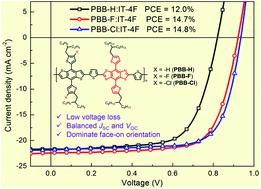当前位置:
X-MOL 学术
›
J. Mater. Chem. A
›
论文详情
Our official English website, www.x-mol.net, welcomes your
feedback! (Note: you will need to create a separate account there.)
High-efficiency organic solar cells enabled by halogenation of polymers based on 2D conjugated benzobis(thiazole)
Journal of Materials Chemistry A ( IF 10.7 ) Pub Date : 2020-06-22 , DOI: 10.1039/d0ta04734a Shuguang Wen 1, 2, 3, 4, 5 , Yonghai Li 1, 2, 3, 4, 5 , Nan Zheng 5, 6, 7, 8 , Ibrahim Oladayo Raji 1, 2, 3, 4, 5 , Chunpeng Yang 1, 2, 3, 4, 5 , Xichang Bao 1, 2, 3, 4, 5
Journal of Materials Chemistry A ( IF 10.7 ) Pub Date : 2020-06-22 , DOI: 10.1039/d0ta04734a Shuguang Wen 1, 2, 3, 4, 5 , Yonghai Li 1, 2, 3, 4, 5 , Nan Zheng 5, 6, 7, 8 , Ibrahim Oladayo Raji 1, 2, 3, 4, 5 , Chunpeng Yang 1, 2, 3, 4, 5 , Xichang Bao 1, 2, 3, 4, 5
Affiliation

|
With the rapid development of non-fullerene acceptors, polymer donor design is critical for the realization of significantly higher power conversion efficiencies in organic solar cells (OSCs). The donor–acceptor (D–A) alternating structure is an effective strategy for the design of polymers due to its advantages in optical absorption, energy level modulation, charge mobilities, etc. Nevertheless, the current development of polymers is restricted in terms of modification of the acceptor unit. In this work, a 2D conjugated acceptor unit of benzobis(thiazole) was designed for constructing wide bandgap polymers. Fluorine and chlorine atoms were introduced into the polymers to modulate the energy levels and film morphology. The photovoltaic performances of the polymers were examined by fabricating devices employing IT-4F as the acceptor. All three polymers exhibit high short-circuit densities (JSCs) of over 21 mA cm−2 in the devices which could be attributed to high extinction coefficient and beneficial face-on orientation, as featured by the polymers based on the 2D conjugated BBT unit. Incorporation of F- or Cl-atoms effectively improved all three photovoltaic parameters open-circuit voltage (VOC), JSC and fill factor. As a result, a high power conversion efficiency of 14.8% was achieved for the chlorinated polymer (PBB-Cl). A high VOC of 0.94 V and JSC of 21.8 mA cm−2 were realized in the devices, indicating well-balanced VOC and JSC values. Dominant face-on orientation was observed for all three polymer films, which is beneficial for charge transport in the vertical direction of the substrate. Given the excellent photovoltaic performance achieved in the devices, the polymer based on the 2D conjugated BBT unit would be a very promising candidate for high performance organic solar cells.
中文翻译:

通过基于2D共轭苯并双(噻唑)的聚合物卤化实现的高效有机太阳能电池
随着非富勒烯受体的迅速发展,聚合物供体的设计对于实现有机太阳能电池(OSC)显着更高的功率转换效率至关重要。由于其在光吸收,能级调制,电荷迁移率等方面的优势,供体-受体(D-A)交替结构是聚合物设计的有效策略。然而,就受体单元的修饰而言,聚合物的当前开发受到限制。在这项工作中,苯并双(噻唑)的二维共轭受体单元被设计用于构造宽带隙聚合物。将氟和氯原子引入聚合物中,以调节能级和薄膜形态。通过使用IT-4F作为受体的制造装置来检查聚合物的光伏性能。所有这三种聚合物均表现出超过21 mA cm -2的高短路密度(J SC)基于2D共轭BBT单元的聚合物所具有的特征是,在这种装置中,这可能归因于高消光系数和有益的面朝取向。F或Cl原子的结合有效地改善了所有三个光伏参数的开路电压(V OC),J SC和填充系数。结果,对于氯化聚合物(PBB-Cl)实现了14.8%的高功率转换效率。在这些器件中实现了0.94 V的高V OC和21.8 mA cm -2的J SC,表明V OC和J SC均衡价值观。对于所有三个聚合物膜都观察到显着的面向正面取向,这对于在基板的垂直方向上的电荷传输是有利的。鉴于这些器件具有出色的光伏性能,基于2D共轭BBT单元的聚合物将成为高性能有机太阳能电池的非常有希望的候选者。
更新日期:2020-07-14
中文翻译:

通过基于2D共轭苯并双(噻唑)的聚合物卤化实现的高效有机太阳能电池
随着非富勒烯受体的迅速发展,聚合物供体的设计对于实现有机太阳能电池(OSC)显着更高的功率转换效率至关重要。由于其在光吸收,能级调制,电荷迁移率等方面的优势,供体-受体(D-A)交替结构是聚合物设计的有效策略。然而,就受体单元的修饰而言,聚合物的当前开发受到限制。在这项工作中,苯并双(噻唑)的二维共轭受体单元被设计用于构造宽带隙聚合物。将氟和氯原子引入聚合物中,以调节能级和薄膜形态。通过使用IT-4F作为受体的制造装置来检查聚合物的光伏性能。所有这三种聚合物均表现出超过21 mA cm -2的高短路密度(J SC)基于2D共轭BBT单元的聚合物所具有的特征是,在这种装置中,这可能归因于高消光系数和有益的面朝取向。F或Cl原子的结合有效地改善了所有三个光伏参数的开路电压(V OC),J SC和填充系数。结果,对于氯化聚合物(PBB-Cl)实现了14.8%的高功率转换效率。在这些器件中实现了0.94 V的高V OC和21.8 mA cm -2的J SC,表明V OC和J SC均衡价值观。对于所有三个聚合物膜都观察到显着的面向正面取向,这对于在基板的垂直方向上的电荷传输是有利的。鉴于这些器件具有出色的光伏性能,基于2D共轭BBT单元的聚合物将成为高性能有机太阳能电池的非常有希望的候选者。











































 京公网安备 11010802027423号
京公网安备 11010802027423号